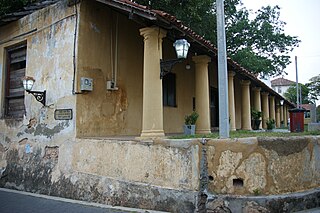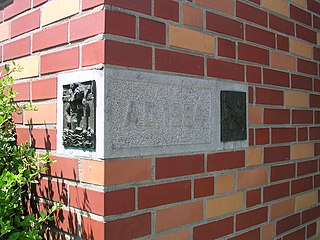
Colombo is the commercial capital and largest city of Sri Lanka by population. According to the Brookings Institution, Colombo metropolitan area has a population of 5.6 million, and 752,993 in the city proper. It is the financial centre of the island and a popular tourist destination. It is located on the west coast of the island and adjacent to the Greater Colombo area which includes Sri Jayawardenepura Kotte, the legislative capital of Sri Lanka and Dehiwala-Mount Lavinia. Colombo is often referred to as the capital since Sri Jayawardenepura Kotte is within the urban area of, and a suburb of, Colombo. It is also the administrative capital of the Western Province and the district capital of Colombo District. Colombo is a busy and vibrant place with a mixture of modern life and colonial buildings and ruins. It was the legislative capital of Sri Lanka until 1982.

Battaramulla is a suburb of the city of Colombo, situated 5.2 miles from the City Centre at Colombo Fort, near the Parliament of Sri Lanka. It is one of the fastest developing administrative, commercial and residential areas in the Colombo District being home to the country's elite. By present Battaramulla has been an important town in Sri Lanka, because of the Sri Lanka government decided to locate all the government department head offices in this town.

National Museum of Colombo, also known as the Sri Lanka National Museum is one of two museums in Colombo. It is the largest museum in Sri Lanka. It is maintained by the Department of National Museum of the central government. The museum holds contains a collections of much importance to Sri Lanka such as the regalia of the country, including the throne and crown of the Kandyan monarchs as well as many other exhibits telling the story of ancient Sri Lanka.

Old Colombo Lighthouse or Colombo Fort Clock Tower is a clock tower and was a lighthouse in Colombo. The lighthouse is no longer operational, but the tower remains and functions as a clock tower. It is located at the junction of Chatham Street and Janadhipathi Mawatha in Colombo fort.

The Old Army Headquarters refers to the former military headquarters complex of the Sri Lanka Army. Situated next to Galle Face Green and Lower Lake Road, the complex bordered the Beira Lake and had its main entrance at the Slave Island end of Baladaksha Mawatha, Colombo 3. The complex also included the Ministry of Defence buildings, located close to the Galle Face terminus of Baladaksha Mawatha. Apart from operational and administrative offices, it contained the centers of several regiments and corps of the Sri Lanka Army, as well as the Colombo Military Hospital and the army sports grounds. The base was demolished in 2012 in preparation for a civilian real estate development project.
The Mayor of Colombo is the Mayor of the Colombo Municipal Council. The post was created in 1866 when the Colombo Municipal Council was established by the Legislative Council of Ceylon. The Mayor is assisted by the Deputy Mayor and a Municipal Commissioner. Since 1944 the majority of the mayors have been from the United National Party.

Fort is the central business district of Colombo in Sri Lanka. It is the financial district of Colombo and the location of the Colombo Stock Exchange (CSE) and the World Trade Centre of Colombo from which the CSE operates. It is also the location of the Bank of Ceylon headquarters. Along the foreshore of the Fort area is the Galle Face Green Promenade, built in 1859 under the governance of Sir Henry George Ward, the Governor of Ceylon during British colonial administration. Fort is also home to the General Post Office, hotels, government departments and offices.
Post and Telegraph Signals was a (reserve) regiment of the Ceylon Army. Raised in 1955 with staff from the Department of Post and Ceylon Telegraph Department. The government hoped to minimized the effects to the Post and Telegraph services in the event of trade union action by mobilizing the personnel attached to this unit. However it was disbanded in 1956 when the leftist S.W.R.D. Bandaranaike became prime minister.
Queen's Cottage is a country house near Nuwara Eliya, Sri Lanka. It is the vacationing and country residence of the President of Sri Lanka. Located within the limits of the Nuwara Eliya Municipal Council along the Queen Elizabeth Drive, it is a protected monument under the Antiquities Ordinance.
The Central Telegraph Office is a building in Colombo, Sri Lanka, that housed the Ceylon Telegraph Department, the precursor to Sri Lanka Telecom. It is situated at Colombo fort along Duke Street, across from the headquarters of the Colombo Metropolitan Police; it was built in 1910 or 1911 and is used by Sri Lanka Telecom.

Victoria Masonic Temple in Colombo, Sri Lanka is the meeting place for the Masonic Lodges in the Colombo area. It was built in 1901 during British rule. It was designed by E. Skinner, an associate of the Royal Institute of British Architects, and built by the Colombo Commercial Company. The building was built in neo-Georgian style mixed with elements of Eastern architecture. After the necessary funding was raised by subscription and debentures, the cornerstone of the building was laid on September 27, 1900 and the building was completed in August 1901 with a formal opening on September 1, 1901.

Tihe Ministry of Health, Nutrition and Indigenous Medicine is the central government ministry of Sri Lanka responsible for health. The ministry is responsible for formulating and implementing national policy on health, nutrition, indigenous medicine and other subjects which come under its purview.

The Nuwara Eliya Post Office is located in the centre of Nuwara Eliya and is one of the oldest post offices in Sri Lanka.

The Kandy General Post Office is the main post office in Kandy, Sri Lanka.

The Galle Fort Post Office is the post office in Galle Fort, Sri Lanka.

The 2nd State Council of Ceylon was a meeting of the State Council of Ceylon, with the membership determined by the results of the 1936 state council election held between 22 February and 7 March 1936. The parliament met for the first time on 17 March 1936 and was dissolved on 4 July 1947.

















